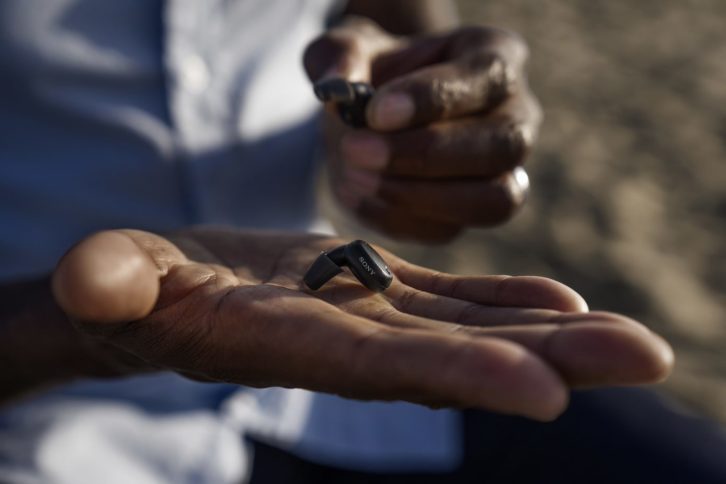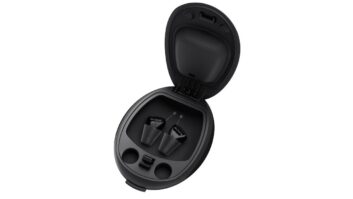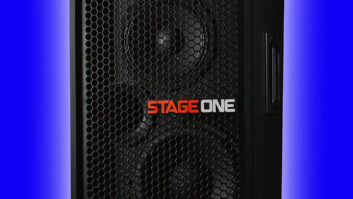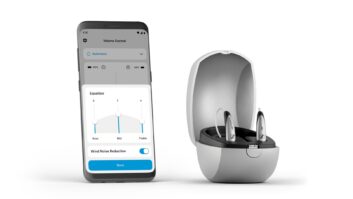
From the early days of ear trumpets to the introduction of bulky analog devices, and now to the discrete receiver-in-canal hearing aids on the market today, the history of hearing augmentation has witnessed remarkable progress over the past 70 years. When Knowles invented balanced armatures for the hearing aid industry in 1954, the team could have never imagined how far the technology would go. A proud pioneer on the journey to the high-performance hearing enhancement solutions consumers enjoy today, Knowles remains the world’s largest producer of transducers for hearing aids.
The National Institute on Deafness & Other Communication Disorders estimates that 15% of American adults report some trouble hearing, and reports that while about 28.8 million US adults could benefit from using hearing aids, only 16% of people actually use them. Despite the widespread prevalence of hearing loss and the major evolution of hearing health technologies, barriers such as cost, stigma, awareness, and affordability have historically blocked the category from widespread awareness and adoption.
The historic October 2022 ruling by the U.S. Food and Drug Administration (FDA) to make over-the-counter (OTC) hearing aids available for sale nationwide to adults with mild-to-moderate perceived hearing loss was a major turning point. One year later, hundreds of brands have come to market with solutions that make hearing aids more accessible, innovative and potentially life-changing for millions of Americans.
The Potential of the Category Rears Its Head

While consumer awareness of OTC hearing aids remains lower than we’d like, the availability of a broader spectrum of accessible hearing health products can potentially transform lives. The availability of OTC hearing aids can provide individuals with direct access to affordable and readily available hearing solutions without requiring professional intervention.* While current solutions scale a large portion of the consumer market, with devices ranging up into thousands of dollars, brands are working to make the devices affordable to all. JLab, for example, unveiled its concept for $99 OTC hearing aids at CES 2023.
This accessibility allows more people to address their hearing concerns promptly and effectively. As well, OTC hearing aids empower individuals by giving them the tools to self-manage their hearing health. This autonomy enables users to adjust settings and tailor their hearing aids to their specific needs, fostering a sense of control and personalized care.
The increased awareness around OTC hearing aids also promotes early intervention, awareness, and hearing loss prevention. By making hearing aids more accessible, individuals are encouraged to seek assistance at the earliest signs of hearing loss, leading to timely intervention and better outcomes. The increasing awareness and diversity in the market have also begun to destigmatize hearing loss. By normalizing the use of hearing aids and promoting the features that entice consumers, the social stigma associated with hearing loss is reduced, encouraging more individuals to seek help and support for their hearing needs.
The Opportunities of OTC Hearing Aids
From a market standpoint, the availability of OTC options enhances consumer choice: The competition in the market has brought a variety of solutions for consumers to choose from, ensuring that users can select from a range of hearing aids with different features and price points that cater to their individual preferences and budget. Since the ruling, many brands have come to market with high-quality, comfortable OTC hearing aids for a broader range of consumers.
As awareness grows, OTC hearing aids also have advanced features that many consumers will find enticing. With built-in Bluetooth for music and podcast streaming, health tracking, and even hearing personalization features, users can enjoy enhanced hearing with the added benefits they expect from their wireless sound technologies. In fact, some leaders in headphone design have entered the hearing aid market, including Jabra, Bose, and Sony.
A recent article in The Wall Street Journal highlights the top OTC hearing aids for consumers, referring to the NCOA ratings. We’re incredibly proud that the seven top OTC hearing aid products on this list incorporate Knowles technologies, including balanced armatures and MEMS microphones, to ensure premium performance for consumers exploring the category. Knowles has unveiled several new solutions to serve OTC hearing aid designs better and provide its partners with high-volume production capabilities suitable for the growing demand.
While balanced armatures have long held their value in the advanced hearing health market, they have also spread to premium sound solutions, such as consumer electronics earphones and professional in-ear monitors. As exceptional audio solutions and hearing health solutions converge and offer new opportunities for personal, accessible, and enjoyable listening, Knowles is proud to partner with leading brands to bring the technology to people of all ages, backgrounds, and needs.
To learn more about OTC hearing aids, visit www.fda.gov/medical-devices/hearing-aids/otc-hearing-aids-what-you-should-know.
*Although over-the-counter hearing aids are gaining popularity, seeking guidance from an audiologist or hearing healthcare provider is highly advisable for proper diagnosis, treatment, and continued advisement. This will ensure that you receive the best care possible.
See also: Executive Insight: When Speakers Are Forged In Silicon













